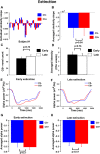Fear conditioning prompts sparser representations of conditioned threat in primary visual cortex
- PMID: 32901822
- PMCID: PMC7647380
- DOI: 10.1093/scan/nsaa122
Fear conditioning prompts sparser representations of conditioned threat in primary visual cortex
Abstract
Repeated exposure to threatening stimuli alters sensory responses. We investigated the underlying neural mechanism by re-analyzing previously published simultaneous electroencephalogram-functional magnetic resonance imaging (EEG-fMRI) data from humans viewing oriented gratings during Pavlovian fear conditioning. In acquisition, one grating (CS+) was paired with a noxious noise, the unconditioned stimulus (US). The other grating (CS-) was never paired with the US. In habituation, which preceded acquisition, and in extinction, the same two gratings were presented without US. Using fMRI multivoxel patterns in primary visual cortex during habituation as reference, we found that during acquisition, aversive learning selectively prompted systematic changes in multivoxel patterns evoked by CS+. Specifically, CS+ evoked voxel patterns in V1 became sparser as aversive learning progressed, and the sparsified pattern appeared to be preserved in extinction. Concomitant with the voxel pattern changes, occipital alpha oscillations were increasingly more desynchronized during CS+ (but not CS-) trials. Across acquisition trials, the rate of change in CS+-related alpha desynchronization was correlated with the rate of change in multivoxel pattern representations of CS+. Furthermore, alpha oscillations co-varied with blood-oxygen-level-dependent (BOLD) data in the ventral attention network, but not with BOLD in the amygdala. Thus, fear conditioning prompts persistent sparsification of voxel patterns evoked by threat, likely mediated by attention-related mechanisms.
Keywords: alpha oscillations; attention; fear conditioning; sparsification; visual representation.
© The Author(s) 2020. Published by Oxford University Press.
Figures








Similar articles
-
Amygdala Adaptation and Temporal Dynamics of the Salience Network in Conditioned Fear: A Single-Trial fMRI Study.eNeuro. 2018 Feb 28;5(1):ENEURO.0445-17.2018. doi: 10.1523/ENEURO.0445-17.2018. eCollection 2018 Jan-Feb. eNeuro. 2018. PMID: 29497705 Free PMC article.
-
Multimodal Imaging Evidence for a Frontoparietal Modulation of Visual Cortex during the Selective Processing of Conditioned Threat.J Cogn Neurosci. 2017 Jun;29(6):953-967. doi: 10.1162/jocn_a_01114. Epub 2017 Mar 2. J Cogn Neurosci. 2017. PMID: 28253082 Free PMC article.
-
Learning pain-related fear: neural mechanisms mediating rapid differential conditioning, extinction and reinstatement processes in human visceral pain.Neurobiol Learn Mem. 2014 Dec;116:36-45. doi: 10.1016/j.nlm.2014.08.003. Epub 2014 Aug 13. Neurobiol Learn Mem. 2014. PMID: 25128878
-
The amygdala: a potential player in timing CS-US intervals.Behav Processes. 2014 Jan;101:112-22. doi: 10.1016/j.beproc.2013.08.007. Epub 2013 Aug 22. Behav Processes. 2014. PMID: 23973708 Review.
-
The role of the basolateral amygdala and infralimbic cortex in (re)learning extinction.Psychopharmacology (Berl). 2019 Jan;236(1):303-312. doi: 10.1007/s00213-018-4957-x. Epub 2018 Jun 30. Psychopharmacology (Berl). 2019. PMID: 29959461 Review.
Cited by
-
Independence Threat or Interdependence Threat? The Focusing Effect on Social or Physical Threat Modulates Brain Activity.Brain Sci. 2024 Apr 9;14(4):368. doi: 10.3390/brainsci14040368. Brain Sci. 2024. PMID: 38672018 Free PMC article.
-
Sensing fear: fast and precise threat evaluation in human sensory cortex.Trends Cogn Sci. 2023 Apr;27(4):341-352. doi: 10.1016/j.tics.2023.01.001. Epub 2023 Jan 31. Trends Cogn Sci. 2023. PMID: 36732175 Free PMC article. Review.
-
Associative learning shapes visual discrimination in a web-based classical conditioning task.Sci Rep. 2021 Aug 3;11(1):15762. doi: 10.1038/s41598-021-95200-6. Sci Rep. 2021. PMID: 34344923 Free PMC article.
-
Auditory aversive generalization learning prompts threat-specific changes in alpha-band activity.Cereb Cortex. 2024 Mar 1;34(3):bhae099. doi: 10.1093/cercor/bhae099. Cereb Cortex. 2024. PMID: 38517176 Free PMC article.
-
Pattern analysis of neuroimaging data reveals novel insights on threat learning and extinction in humans.Neurosci Biobehav Rev. 2022 Nov;142:104918. doi: 10.1016/j.neubiorev.2022.104918. Epub 2022 Oct 15. Neurosci Biobehav Rev. 2022. PMID: 36257347 Free PMC article. Review.
References
-
- Allen P.J., Polizzi G., Krakow K., Fish D.R., Lemieux L. (1998). Identification of EEG events in the MR scanner: the problem of pulse artifact and a method for its subtraction. NeuroImage, 8(3), 229–39. Headley and Weinberger, 2011; Moran and Katz, 2014. - PubMed
-
- Amaral D.G., Behniea H., Kelly J.L. (2003). Topographic organization of projections from the amygdala to the visual cortex in the macaque monkey. Neuroscience, 118(4), 1099–120. - PubMed
-
- Armony J.L., Dolan R.J. (2002). Modulation of spatial attention by fear-conditioned stimuli: an event-related fMRI study. Neuropsychologia, 40(7), 817–26. - PubMed

